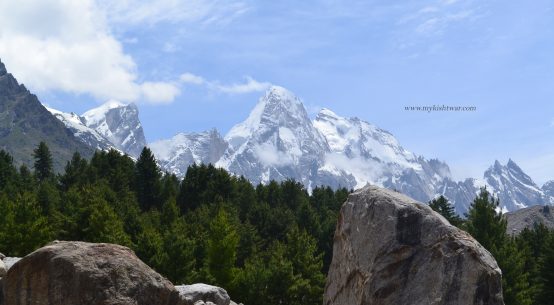
With the arrival of the great Sofi Saint, Shah Farid-ud-Din of Baghdad along with his four disciples Darvesh Mohd. Yaar Mohd, Syed Baha-ud-din and Shah Abdal in Kishtwar during the rule of Raja Jai Singh, Islam spread far and wide in Doda region, Dudu Basant Garh, mahore, Gulabgarh and Chennai of Udhampur District. Shah Farid-ud-Din was the descendent of the saintly family of Syed Abdul Qadir of Baghdad and reached Delhi, along with his wife Zahida Bibi. Mughal Emperor, Shah Jahan treated him as a state guest and made him stay at Delhi and Agra for sometime before he started journey for Kishtwar and Doda. As per the orders of the emperor, Hafiz Abdul Qasim accompanied Shah Sahib from Delhi to facilitate his journey. He, along with Shah Sahib, made Kishtwar his permanent home and acted as tutor to Shah Akhyar-ud-Din. The high spiritual status of Shah Farid-ud-Din and the miracles done by him impressed everyone coming into his contact. Regarding his spiritual powers, it is said that he along with his disciples crossed the river Chenab at Bhandarkot on a sheet, when guards of Raja Jai Singh had closed the bridges at Kuriya and Bhandarkot refusing entry to the saint and his party.
At Kishtwar he, first, stayed at Drangwaji near Neelkanth Mahadev temple and soon the news of the arrival of this divinely personality spread far and wide. People started thronging this place to take his blessings. Raja Jai Singh, first, acted arrogantly but when his bed was overturned during sleep and the Faqir appeared in his dream, he got frightened and forced to go to the ‘Faqir’ the next morning. Under his influence, the Raja converted to slam assuming the name ‘Bakhtiar Khan’. The Raja got a house constructed for the saint near his palace and conversion of people to Islam got a fillip not only in Kishtwar but far and wide.
Durbar-E-Faridia Kishtwar
 Hazrat Shah Farid-ud-Din died on 7th Haar at age of 99. He was buried in his house at Astaan Baala, Kishtwar. Later on his son Shah Akhyar-ud-Din and Shah Anwar-ud-Din, wives Zahida Bibi, Mai Malahat, Mai Roshan Dil, his disciples Hazrat Dervesh Mohd and Yaar Mohd, who had accompanied him from Baghdad, were also buried here. In Durbar-e-Faridia, Roza Faridia, i.e. grave of Shah Farid-ud-Din is towards thw west of the inner drawing room while that of Shah Akhyar-ud-Din is in the outer drawing room. Shah Anwar –ud-Din is buried to the east of Roza Faridia. All the three wives are buried in a closet at the feet of Shah Farid-ud-Din. Hazrat Darvesh Mohd. and Yaar Mohd. Are buried in the courtyard. Tth of Haar is celebrated as ’URS’ of Shah Farid-ud-Din every year in which thousands of pilgrims coming from all over the state and the adjoining states participate. Beside Namaz, religious discourse and other rituals, sacred relics of Shah Sahibare also displayed. These include the Turban and the cap inherited from Gous-ul-Azam, a sword, a staff, two shirts of Shah Farid-ud-Din and Shah Akhyar-ud-Din, locks of hair of all the three sons, hockey stick, the stamp of Shah Farid-ud-Din, eight long caps, comb etc.
Hazrat Shah Farid-ud-Din died on 7th Haar at age of 99. He was buried in his house at Astaan Baala, Kishtwar. Later on his son Shah Akhyar-ud-Din and Shah Anwar-ud-Din, wives Zahida Bibi, Mai Malahat, Mai Roshan Dil, his disciples Hazrat Dervesh Mohd and Yaar Mohd, who had accompanied him from Baghdad, were also buried here. In Durbar-e-Faridia, Roza Faridia, i.e. grave of Shah Farid-ud-Din is towards thw west of the inner drawing room while that of Shah Akhyar-ud-Din is in the outer drawing room. Shah Anwar –ud-Din is buried to the east of Roza Faridia. All the three wives are buried in a closet at the feet of Shah Farid-ud-Din. Hazrat Darvesh Mohd. and Yaar Mohd. Are buried in the courtyard. Tth of Haar is celebrated as ’URS’ of Shah Farid-ud-Din every year in which thousands of pilgrims coming from all over the state and the adjoining states participate. Beside Namaz, religious discourse and other rituals, sacred relics of Shah Sahibare also displayed. These include the Turban and the cap inherited from Gous-ul-Azam, a sword, a staff, two shirts of Shah Farid-ud-Din and Shah Akhyar-ud-Din, locks of hair of all the three sons, hockey stick, the stamp of Shah Farid-ud-Din, eight long caps, comb etc. One distinctive aspect of Shah Sahib’s personality was that in his company deliberations would go on good conduct, piety, God-realization and human brotherhood with no criticism of other faiths. For the seekers of divine knowledge, the Durbaar’s of Shah Farid-ud-Din and Shah Asra-ud-Din are a source of inspiration, divine bounties and a treasure house of God’s favours.
Durbaar-E-Asraria
 On the south eastern corner of ‘Chowgan’ stands the sacred and famous shrine of Shah Asrar-ud-Din, son of Shah Farid-ud-Din and born to his wifr from Baghdad, Zahida Bibi in 1667 A.D. About Shah Asrar-ud-Din, it is said in Rozat-ul-Aarfin of Peer Zia-ud-Din that he was a born saint and would talk to his mother even when he was in her womb. Soon people who came to his contact wrer attracted towards him. He performed miracles to the astonishment of all. He began foretelling the future events, making the walls to walk and bringing the dead back to life. When his father, Hazrat Shah Farid-ud-Din witnessed manifold miracles I his son, he prayed to God that he call his son back to him. Mon 25th of Kartik he ordered Syed Bahud-ud-Din to bring a cup full of sugar candy syrup. Reciting Quranic hymns he blew over the syrup and ordered Sgag Asrar-ud-Din to drink it. Like an obedient son, he soon drank it. Surprisingly he was no more in this world and was thus, called back by God.
On the south eastern corner of ‘Chowgan’ stands the sacred and famous shrine of Shah Asrar-ud-Din, son of Shah Farid-ud-Din and born to his wifr from Baghdad, Zahida Bibi in 1667 A.D. About Shah Asrar-ud-Din, it is said in Rozat-ul-Aarfin of Peer Zia-ud-Din that he was a born saint and would talk to his mother even when he was in her womb. Soon people who came to his contact wrer attracted towards him. He performed miracles to the astonishment of all. He began foretelling the future events, making the walls to walk and bringing the dead back to life. When his father, Hazrat Shah Farid-ud-Din witnessed manifold miracles I his son, he prayed to God that he call his son back to him. Mon 25th of Kartik he ordered Syed Bahud-ud-Din to bring a cup full of sugar candy syrup. Reciting Quranic hymns he blew over the syrup and ordered Sgag Asrar-ud-Din to drink it. Like an obedient son, he soon drank it. Surprisingly he was no more in this world and was thus, called back by God. He was eighteen then. So his ‘URS’ is celebrated on 25th Kartik every year with great devotion and fanfare. After his death, he was taken to Chowgan for Namaz-e-Jinaza and burial on reaching the upper end of the Chowgan, his dead body became too heavy to lift. So, under the orders of his father, he was laid to rest there. A grand tomb was erected on his grave. Thousands of devotees visit the shrine for seeking blessings of this great saint and especially on the day of ‘URS’ the mammoth gathering speaks of the devotion of his followers.




bro can you please tell me that sarthal mata and malh mata are same. Few people has told us that malh mata and sarthal mata are same. they share two names some call them malh mata and some call them sarthal mata. so can you please tell me that is this write or wrong. And if malh mata’s temple is different then please tell me the location of it or guide me by sending road root on my mail id : aditya_pathania01@yahoo.co.in
Malh mata is our kull devi so that is why are serching for her temple.
bro hoping that you will help us in this matter.
thanking you
Aditya Pathania